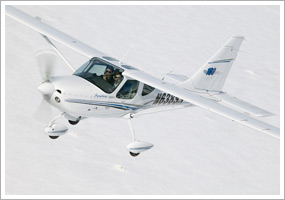| The following stories from the Dec. 3, 2010, edition of AOPA ePilot were provided to AOPA members who expressed an interest in the particular subject areas. Any AOPA member can receive information tailored to their areas of interest by updating their preferences online. |
training tipsNew season, new procedures
The weather now comes under the influence of such big-picture seasonal changes as the southward migration of the jet stream, with its capacity for producing strong winds aloft or low-level turbulence. The easy engine starts of summer—and worries about overheating air-cooled powerplants—give way to morning preheats and careful warm-ups once the prop is turning. “Warm up the engine at 1,000 to 1,200 rpm unless it's necessary to reduce rpm to keep from exceeding the oil pressure redline. As the oil warms up, the rpm can be increased. Allow plenty of time for the engine to warm up,” Steven W. Ells advised in this edition of the AOPA Pilot magazine series “Airframe and Powerplant.” Many aircraft use less-viscous engine oil in winter. What is the oil recommended for your trainer, and under what temperature conditions should the conversion come? Why is the switch recommended? See the article cited above, and your trainer’s pilot’s operating handbook. Does your aircraft have a winterization kit installed? (See the Jan. 2, 2004, “ Training Tip: Engine TLC.”) Dress warmly. A good cabin heater is a blessing for those cold mornings flying the traffic pattern. Most trainers harness exhaust-system heat to keep the cabin comfortable. “The system, although simple, does have one major downside. In most light aircraft installations, because the residual heat from the exhaust is what powers the cabin heater, a leak in the exhaust system could mean exhaust coming into the cockpit. And that means carbon monoxide could be entering as well. Carbon monoxide is an odorless, colorless gas that can incapacitate pilots and passengers,” Alton K. Marsh said in the November Flight Training’s “ What it looks like.” That’s a good reason to check that your aircraft is equipped with a carbon monoxide detector. Whether you are visiting a cold climate or the cold is coming your way, inspect your aircraft wings and tail for frost accumulations. Remove any frost before flight. Review wing-contamination avoidance strategies in this Safety Brief by the Air Safety Institute. Fly through winter with some care and preparation! training productsSporty’s 2010 Christmas ornament is a DC-3Sporty’s Pilot Shop’s crystal tree ornaments are a holiday tradition and collectible for many pilots. This year’s entry is a DC-3 in honor of the airplane’s seventy-fifth anniversary. (By the way, did you see the December 2010 AOPA Pilot article on that very topic?) Order your ornament online for $24.95, or call 800/SPORTYS. Note: Products listed have not been evaluated by ePilot editors unless otherwise noted. AOPA assumes no responsibility for products or services listed or for claims or actions by manufacturers or vendors. final exam
Question: What is the difference between best rate of climb speed and best angle of climb speed?
Answer: The best rate of climb speed, also known as V Y, provides the greatest gain in altitude in the least amount of time. The best angle of climb speed (also known as V X) provides the greatest gain in altitude over a given horizontal distance. The different airspeeds that either limit or result in specific aircraft performance are known as “V speeds”—V for velocity. The different V-speed abbreviations are listed in the federal aviation regulations under Part 1: Definitions and Abbreviations. For more information on all the V speeds and their effect on aircraft safety and performance, read the Flight Training article “ Airspeed.”
Got a question for our technical services staff? E-mail [email protected] or call the Pilot Information Center, 800/872-2672. Don’t forget the online archive of “Final Exam” questions and answers, searchable by keyword or topic. |
 The coming of winter calls on pilots to make many operational changes, with seasonal weather trends changing and aircraft in need of being readied for the frigid flying season.
The coming of winter calls on pilots to make many operational changes, with seasonal weather trends changing and aircraft in need of being readied for the frigid flying season.

